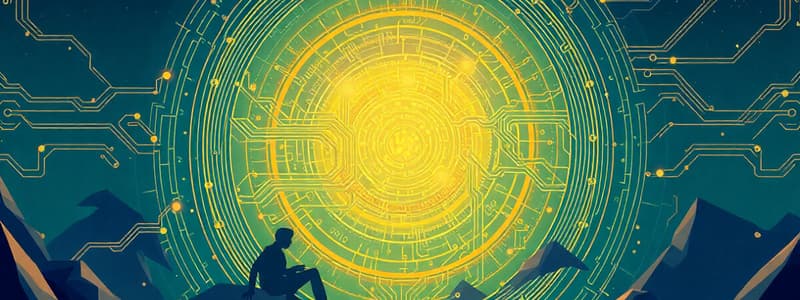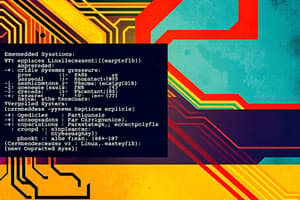Podcast
Questions and Answers
What is a key characteristic of embedded operating systems regarding their resource utilization?
What is a key characteristic of embedded operating systems regarding their resource utilization?
- They are designed to have a low resource footprint. (correct)
- They run all applications in a virtual environment.
- They optimize for multitasking performance.
- They require high processing power and large memory capacity.
Which multitasking type allocates a specific time slice to tasks and enforces control over resource allocation?
Which multitasking type allocates a specific time slice to tasks and enforces control over resource allocation?
- Preemptive multitasking (correct)
- Cooperative multitasking
- Dynamic multitasking
- Static multitasking
Which of the following is NOT typically a focus of embedded operating systems?
Which of the following is NOT typically a focus of embedded operating systems?
- Frequent updates and patches (correct)
- Reliability and stability
- Customization for specific applications
- Real-time processing requirements
What is the primary purpose of process synchronization in multitasking environments?
What is the primary purpose of process synchronization in multitasking environments?
What role does process scheduling play in an operating system?
What role does process scheduling play in an operating system?
What is the primary role of device drivers in the context of interrupts?
What is the primary role of device drivers in the context of interrupts?
What happens when an interrupt occurs?
What happens when an interrupt occurs?
What is the function of the Interrupt Descriptor Table (IDT)?
What is the function of the Interrupt Descriptor Table (IDT)?
What does registering an interrupt handler entail?
What does registering an interrupt handler entail?
What is a potential outcome of nested interrupts?
What is a potential outcome of nested interrupts?
Why would a device driver mask interrupts?
Why would a device driver mask interrupts?
During system initialization, what does the operating system do with the IDT?
During system initialization, what does the operating system do with the IDT?
What is the primary role of device drivers within an operating system?
What is the primary role of device drivers within an operating system?
Which of the following best describes the 'Plug and Play' functionality?
Which of the following best describes the 'Plug and Play' functionality?
What does the abstraction layer provided by device drivers accomplish?
What does the abstraction layer provided by device drivers accomplish?
What is a key function of Board I/O Drivers during system boot-up?
What is a key function of Board I/O Drivers during system boot-up?
How do device drivers handle data transfer for output devices?
How do device drivers handle data transfer for output devices?
What is the role of the Interrupt Service Routine (ISR) in a Board I/O Driver?
What is the role of the Interrupt Service Routine (ISR) in a Board I/O Driver?
What aspect of power management do device drivers handle?
What aspect of power management do device drivers handle?
What do drivers monitor regarding the status of hardware?
What do drivers monitor regarding the status of hardware?
What is a characteristic of an Embedded Operating System?
What is a characteristic of an Embedded Operating System?
Why is compliance with standards important for Board I/O Drivers?
Why is compliance with standards important for Board I/O Drivers?
What purpose do device drivers serve in a computer system?
What purpose do device drivers serve in a computer system?
Which of the following techniques is commonly used by device drivers to ensure data integrity?
Which of the following techniques is commonly used by device drivers to ensure data integrity?
What is the significance of acknowledging interrupts in device driver functionality?
What is the significance of acknowledging interrupts in device driver functionality?
What is one of the main roles of memory device drivers?
What is one of the main roles of memory device drivers?
What is a primary function of RAM drivers within memory device drivers?
What is a primary function of RAM drivers within memory device drivers?
Which of the following describes the interrupt context in which ISRs operate?
Which of the following describes the interrupt context in which ISRs operate?
What function do memory drivers serve when it comes to error handling?
What function do memory drivers serve when it comes to error handling?
What is the role of a Hardware Abstraction Layer (HAL) in memory device drivers?
What is the role of a Hardware Abstraction Layer (HAL) in memory device drivers?
What type of memory drivers control access to read-only memory (ROM)?
What type of memory drivers control access to read-only memory (ROM)?
What is the primary function of on-board bus device drivers?
What is the primary function of on-board bus device drivers?
Which of the following best describes plug and play functionality facilitated by device drivers?
Which of the following best describes plug and play functionality facilitated by device drivers?
How do device drivers handle error management?
How do device drivers handle error management?
What is the role of the primary bus driver in a driver stack?
What is the role of the primary bus driver in a driver stack?
Which protocol is specifically associated with the I2C bus?
Which protocol is specifically associated with the I2C bus?
What is a significant characteristic of each on-board bus?
What is a significant characteristic of each on-board bus?
What is the relationship between hardware manufacturers and device drivers?
What is the relationship between hardware manufacturers and device drivers?
Which component of the I2C controller generates clock signals when acting as a bus master?
Which component of the I2C controller generates clock signals when acting as a bus master?
What should be initialized to start the I2C bus on the MPC860?
What should be initialized to start the I2C bus on the MPC860?
What does error handling by device drivers typically involve?
What does error handling by device drivers typically involve?
Flashcards
Interrupt
Interrupt
A signal from a hardware device to the CPU requesting attention, allowing a device to preempt the CPU's current task.
Interrupt Service Routine (ISR)
Interrupt Service Routine (ISR)
A routine in a device driver that handles an interrupt and performs necessary tasks when a hardware device requests attention.
Device Driver
Device Driver
Software that acts as an intermediary between the operating system and a hardware device, particularly for handling interrupts.
Interrupt Descriptor Table (IDT)
Interrupt Descriptor Table (IDT)
Signup and view all the flashcards
Interrupt Handling
Interrupt Handling
Signup and view all the flashcards
Interrupt Priority
Interrupt Priority
Signup and view all the flashcards
Interrupt Masking
Interrupt Masking
Signup and view all the flashcards
Device Driver
Device Driver
Signup and view all the flashcards
Interrupt Handling
Interrupt Handling
Signup and view all the flashcards
Interrupt Service Routine (ISR)
Interrupt Service Routine (ISR)
Signup and view all the flashcards
Data Synchronization
Data Synchronization
Signup and view all the flashcards
Memory Device Driver
Memory Device Driver
Signup and view all the flashcards
On-board Bus
On-board Bus
Signup and view all the flashcards
Hardware Abstraction Layer (HAL)
Hardware Abstraction Layer (HAL)
Signup and view all the flashcards
Error Handling
Error Handling
Signup and view all the flashcards
Interrupt Context vs Process Context
Interrupt Context vs Process Context
Signup and view all the flashcards
On-board bus device driver
On-board bus device driver
Signup and view all the flashcards
Bus protocol
Bus protocol
Signup and view all the flashcards
Device Driver Development
Device Driver Development
Signup and view all the flashcards
Plug-and-Play
Plug-and-Play
Signup and view all the flashcards
Bus Communication Protocol
Bus Communication Protocol
Signup and view all the flashcards
Driver Stack
Driver Stack
Signup and view all the flashcards
Error Handling (drivers)
Error Handling (drivers)
Signup and view all the flashcards
Resource Management (drivers)
Resource Management (drivers)
Signup and view all the flashcards
I2C protocol
I2C protocol
Signup and view all the flashcards
Bus Initialization
Bus Initialization
Signup and view all the flashcards
Device Driver
Device Driver
Signup and view all the flashcards
Plug and Play (PnP)
Plug and Play (PnP)
Signup and view all the flashcards
Board I/O Driver
Board I/O Driver
Signup and view all the flashcards
Communication Protocol
Communication Protocol
Signup and view all the flashcards
Error Handling
Error Handling
Signup and view all the flashcards
Driver Stack
Driver Stack
Signup and view all the flashcards
Embedded OS
Embedded OS
Signup and view all the flashcards
Hardware Abstraction
Hardware Abstraction
Signup and view all the flashcards
Interrupt Handling
Interrupt Handling
Signup and view all the flashcards
Power Management
Power Management
Signup and view all the flashcards
Real-time Embedded OS
Real-time Embedded OS
Signup and view all the flashcards
Low Resource Footprint
Low Resource Footprint
Signup and view all the flashcards
Embedded Linux
Embedded Linux
Signup and view all the flashcards
Multitasking (Preemptive)
Multitasking (Preemptive)
Signup and view all the flashcards
Memory Hierarchy
Memory Hierarchy
Signup and view all the flashcards




